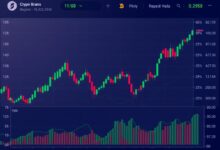Top low-fee crypto exchanges in 2025

Choosing the right platform can significantly influence your trading success. For those prioritizing minimal costs, several options stand out in 2025. Consider platforms like Binance and Kraken, known for their competitive pricing structures and user-friendly interfaces.
Binance offers a tiered fee system, allowing traders to benefit from lower rates based on their trading volume. This structure is particularly advantageous for high-frequency traders looking to maximize profits. Furthermore, they provide a wide range of trading pairs and advanced tools for analysis.
Kraken, on the other hand, appeals to a different segment with its robust security features and transparent fee schedule. Their comprehensive reviews highlight a solid reputation among users who appreciate reliability alongside cost-effectiveness. Both platforms excel in providing a seamless experience while maintaining transparency in their fee policies.
When evaluating these options, it’s essential to conduct a thorough comparison of their offerings. Analyzing user feedback and performance metrics can guide you toward making an informed decision that aligns with your trading strategy.
Top Features to Compare
Prioritize these attributes during your assessment of trading platforms:
- Transaction Costs: Analyze both maker and taker charges. Platforms often present different structures, impacting overall profitability.
- Withdrawal Fees: Examine costs associated with transferring assets off the platform. Lower withdrawal fees can significantly enhance your return on investment.
- User Experience: A streamlined interface is key. Evaluate how intuitive the navigation is and whether features like charts and trading tools are easily accessible.
- Supported Assets: Ensure that the platform lists a diverse array of cryptocurrencies. Greater selection allows for more strategic trading opportunities.
- Security Protocols: Investigate measures in place to protect user funds and data. Look for two-factor authentication, cold storage options, and insurance policies.
- Customer Support: Responsive assistance can make or break your experience. Check available channels such as live chat, email support, or dedicated account managers.
- Trading Options: Assess the variety of trading types offered–spot trading, margin options, futures contracts–all contribute to flexibility in strategy execution.
- Liquidity Levels: Higher liquidity means better price stability and faster transactions. Research average trade volumes to gauge this factor effectively.
This detailed comparison will guide you in making informed decisions tailored to your trading needs.
How to Choose Wisely
Prioritize platforms with transparent pricing structures. Investigate how they calculate their charges, including trading costs and withdrawal expenses. A clear breakdown empowers informed decisions.
Analyze liquidity levels on each platform. High liquidity generally translates into better prices and reduced slippage during transactions, enhancing your trading experience significantly.
Consider the variety of supported assets. Platforms offering a diverse range of cryptocurrencies can provide opportunities for strategic diversification, reducing risk in volatile markets.
Examine user feedback meticulously. Reviews and ratings from other traders highlight real-world experiences that can reveal potential issues or advantages not immediately evident through official channels.
Evaluate security measures rigorously. Look for platforms utilizing robust protocols such as two-factor authentication (2FA) and cold storage options to safeguard your investments effectively.
Investigate customer support availability and responsiveness. Efficient assistance can resolve issues quickly, which is critical during high-stakes trading moments.
Assess educational resources provided by the platform. Access to tutorials, market analyses, and trading strategies can enhance your skills and confidence in making investment decisions.
Finally, compare mobile accessibility across various platforms. A well-designed mobile application allows for convenient trading on-the-go, ensuring you remain connected to the market at all times.
Exchange Security Measures
Prioritize platforms employing multi-factor authentication (MFA) to enhance account protection. This method significantly reduces unauthorized access, ensuring that only verified users can perform transactions.
Look for exchanges utilizing cold storage solutions to safeguard the majority of digital assets. By keeping funds offline, these platforms minimize exposure to online threats and hacking attempts.
Regular security audits and penetration testing by third-party firms are indicators of a proactive approach to vulnerability management. Ensure the exchange you choose undergoes frequent assessments to identify and mitigate potential risks.
Check for insurance policies on held assets. Some providers offer coverage against breaches or losses, adding an extra layer of confidence in asset safety. Review the terms carefully to understand the extent of this protection.
Encryption protocols play a vital role in data security. Confirm that platforms utilize strong encryption methods for both user data and transaction processes, making it difficult for malicious actors to intercept sensitive information.
Transparency regarding security incidents is crucial. Choose services that openly communicate their response strategies in case of breaches, demonstrating accountability and a commitment to user trust.
A responsive customer support team is essential for addressing security concerns promptly. Evaluate platforms with accessible support channels that can assist users effectively during emergencies or suspicious activities.
Finally, keep an eye on community feedback through reviews and forums. User experiences often reveal insights into how well an exchange handles security issues and implements protective measures over time.
User Experience Insights
Prioritize platforms with intuitive interfaces. A well-designed layout simplifies trading and reduces the learning curve for newcomers. Features like customizable dashboards allow users to tailor their experience based on individual preferences.
Examine mobile application performance. High-quality apps enhance accessibility, enabling seamless trading on-the-go. Look for features such as real-time notifications and easy order execution within these applications.
Evaluate customer support options. Responsive assistance through live chat or dedicated phone lines can significantly impact user satisfaction during critical trading moments. Check platform reviews to gauge support reliability.
Consider community engagement tools, such as forums or social media integration. Platforms that encourage user interaction foster a sense of belonging and provide opportunities for knowledge sharing among traders.
Analyze transaction speed and reliability. Fast processing times during peak trading hours are essential for optimal performance. Research user feedback regarding the platform’s ability to handle high volumes without lagging.
Review educational resources provided by the platforms. Comprehensive guides, tutorials, and webinars equip users with necessary skills and insights to make informed trading decisions, enhancing overall experience.
Finally, look into user feedback mechanisms. Platforms that actively solicit and implement suggestions from their community demonstrate commitment to improvement and adaptability in meeting trader needs.







